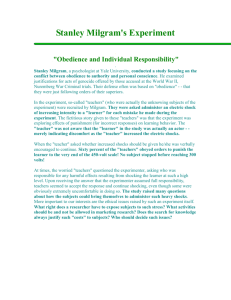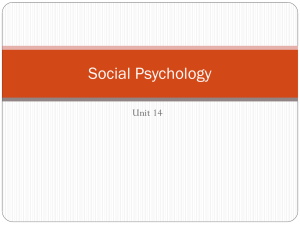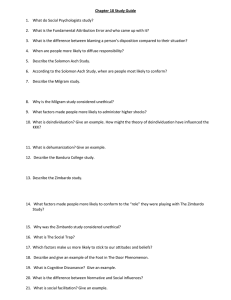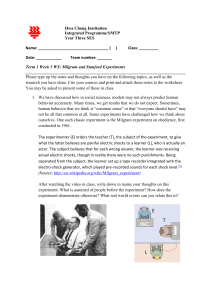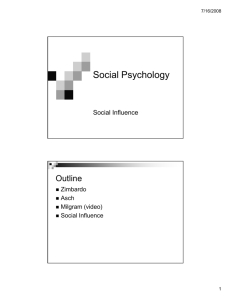1.1
advertisement
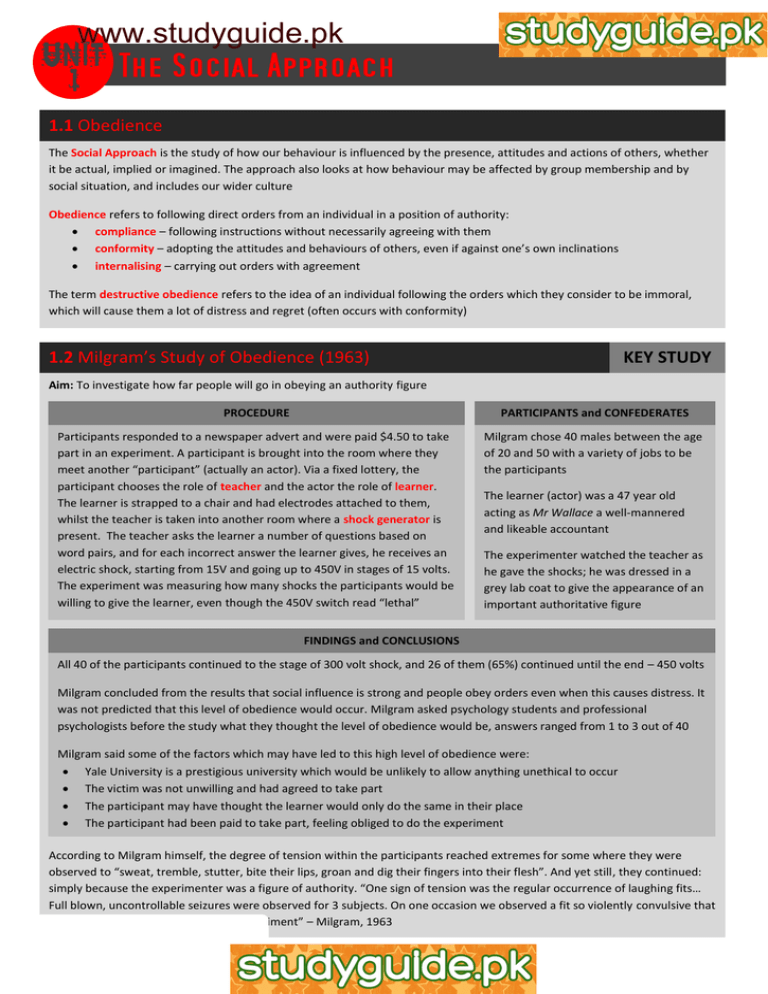
www.studyguide.pk 1.1 Obedience The Social Approach is the study of how our behaviour is influenced by the presence, attitudes and actions of others, whether it be actual, implied or imagined. The approach also looks at how behaviour may be affected by group membership and by social situation, and includes our wider culture Obedience refers to following direct orders from an individual in a position of authority: compliance – following instructions without necessarily agreeing with them conformity – adopting the attitudes and behaviours of others, even if against one’s own inclinations internalising – carrying out orders with agreement The term destructive obedience refers to the idea of an individual following the orders which they consider to be immoral, which will cause them a lot of distress and regret (often occurs with conformity) 1.2 Milgram’s Study of Obedience (1963) KEY STUDY Aim: To investigate how far people will go in obeying an authority figure PROCEDURE PARTICIPANTS and CONFEDERATES Participants responded to a newspaper advert and were paid $4.50 to take part in an experiment. A participant is brought into the room where they meet another “participant” (actually an actor). Via a fixed lottery, the participant chooses the role of teacher and the actor the role of learner. The learner is strapped to a chair and had electrodes attached to them, whilst the teacher is taken into another room where a shock generator is present. The teacher asks the learner a number of questions based on word pairs, and for each incorrect answer the learner gives, he receives an electric shock, starting from 15V and going up to 450V in stages of 15 volts. The experiment was measuring how many shocks the participants would be willing to give the learner, even though the 450V switch read “lethal” Milgram chose 40 males between the age of 20 and 50 with a variety of jobs to be the participants The learner (actor) was a 47 year old acting as Mr Wallace a well-mannered and likeable accountant The experimenter watched the teacher as he gave the shocks; he was dressed in a grey lab coat to give the appearance of an important authoritative figure FINDINGS and CONCLUSIONS All 40 of the participants continued to the stage of 300 volt shock, and 26 of them (65%) continued until the end – 450 volts Milgram concluded from the results that social influence is strong and people obey orders even when this causes distress. It was not predicted that this level of obedience would occur. Milgram asked psychology students and professional psychologists before the study what they thought the level of obedience would be, answers ranged from 1 to 3 out of 40 Milgram said some of the factors which may have led to this high level of obedience were: Yale University is a prestigious university which would be unlikely to allow anything unethical to occur The victim was not unwilling and had agreed to take part The participant may have thought the learner would only do the same in their place The participant had been paid to take part, feeling obliged to do the experiment According to Milgram himself, the degree of tension within the participants reached extremes for some where they were observed to “sweat, tremble, stutter, bite their lips, groan and dig their fingers into their flesh”. And yet still, they continued: simply because the experimenter was a figure of authority. “One sign of tension was the regular occurrence of laughing fits… Full blown, uncontrollable seizures were observed for 3 subjects. On one occasion we observed a fit so violently convulsive that it was necessary to call a halt to the experiment” – Milgram, 1963 www.studyguide.pk 1.3 Evaluation of Milgram’s Study of Obedience The experiment’s results at the time were not generalisable for a number of reasons. First of all, the study only used men of a certain age, which did not show anything of women or those from other ages. Also, the experiments were only conducted in America, so the findings may have been ethnocentric (confined to one country) as they had not been supported elsewhere The main measure of a study’s reliability is how replicable it is: because of the strong controls in this experiment, it is replicable and replicating it is a good measure of its reliability. The experiment was repeated by Milgram, himself, among other psychologists, and it was shown that the results were reliable Milgram’s work had practical value because it showed that individuals have a tendency towards destructive obedience (obeying orders which cause yourself moral distress). This helped to explain obeying behaviour, such as that of the Nazis The study has low ecological validity (the task took place in a laboratory where normal behaviour was not observed) The study has high experimental validity (there were strong controls making it experimentally correct) But the biggest criticism of Milgram’s study is on ethical grounds. Participants were deceived, as they were not informed as to the true nature of the experiment: they were told it was a study on memory, it was actually on obedience. Whilst technically they had the right to withdraw, the experimenters used verbal prompts to pressurise them into staying. Also, many of the participants came to much distress during the experiment, as described in the box above 1.4 Variations of the Milgram Experiment Some of the main variations of the Milgram experiment are listed below: %age giving final 450V shock Original study The subject would administer the shocks to a learner (actor) who earned the role of learner via a fixed lottery Change in location The same experiment was carried out in a run-down office block, instead of the original location, which was Yale University Learner’s presence in the room In one variation, the learner was physically present in the room with the subject, so he had to watch the learner be shocked, and if he refused to touch the shock plate, the subject was told to hold the learner’s hand down Experimenter not present in the room In this variation, the experimenter was not in the same room as the teacher, and all communication between the teacher and experimenter was done via a telephone Increase the number of teachers Another experiment used three teachers, two of whom were actors, and so only one was the real subject. They would behave as though they were also being studied. The first acting teacher would drop out at 150V, the second at 210V), the third (real subject) was then free to drop out at any point Conflicting experimenters In this variation, there were two experimenters present who would conflict with each other, this means they would argue over what was best to do next and would often give the teacher contradictory instructions 1.5 Meeus and Raaijmakers (1986) 65% (26/40) 41% (19/40) 30% (12/40) 23% (9/40) 10% (4/40) 0% (0/40) KEY STUDY Aim: To investigate destructive obedience in the everyday situation of a job interview Wim Meeus and Quinten Raaijmakers wanted to replicate Milgram’s experiment but wished to improve on two issues they found with his original study: - Milgram’s participants were assured there would be no permanent damage to the “learners” - The form of punishment would have been old-fashioned according to Meeus and Raaijmakers www.studyguide.pk PROCEDURE The aim was to assess how the participants would handle destructive obedience in the everyday situation of a job interview and to what extent they would obey orders to psychologically abuse a job applicant i ii iii iv There were three people involved: a university researcher, a “job applicant” (an actor), and the participant The applicant was to follow a script, answering 32 oral multiple-choice questions to get the job The participant was told the job required the ability to handle stress, so they had to issue psychological abuse for each incorrect answer the applicant gave: there were 15 negative comments (stress remarks) to be made in total, ranging from “your answer is wrong” to “I think you’d be better suited for a lower-function job” The stress remarks would eventually lead to the interviewee failing and not getting the job There were 39 participants taking part in this study, and these were separated into two groups. Those in the experimental group (24 participants) were told when to make the stress remarks by the experimenter. Those in the control group (15 participants) could choose when and even whether or not to make the remarks at all Also, there were variations of the experiment: Variation 1 – the experimenter was not present in the room during the interview (22 participants used) Variation 2 – two other “participants” (also actors) were present, who quit after the tenth remark (19 participants used) FINDINGS and CONCLUSIONS Number of participants who… Original Study Variation 1 Variation 2 Made all 15 stress remarks 92% (22/24)* 36% (8/22) 16% (3/19) 73% 81% 84% 4% 5% 0% 23% 14% 16% Believed the experiment was real Thought the experiment was a hoax Were unsure if the experiment was real *All 22 of these participants were from the experimental group (none of the control group went through to the end) Meeus and Raaijmakers drew three main conclusions from the experiment to explain the higher levels of obedience: physical violence has more of an immediate impact than psychological harm consent levels were different (i.e. the participants knew they were going to be doing what they did, Milgram’s participants did not explicitly know they would be administering physical harm to the learner the victim was more dependent on the outcome (they had to continue going to get the job EVALUATION The study builds on Milgram’s by focusing on two areas which Meeus and Raaijmakers saw needing attention Due to the strong controls, the experiment is replicable so reliability can be tested and cause-andeffect conclusions could be drawn The study is a lab experiment and the task is artificial, therefore lacking validity Although the findings were usefully compared with Milgram’s, there are other factors which could have affected the data, such as different cultures, or different times (they were 20 years apart) 1.6 Agency Theory The participants of Milgram’s experiments felt moral strain as they gave the shocks to the learners. They were aware that what they were doing is immoral, but felt obliged to continue because a person of authority was telling them to do so Milgram put forward a theory, agency theory to try and explain the different states people can be in when blindly obeying those people in a position of authority. He noticed that all of his participants in the original study went to 300 volts, which showed that it was as if just by agreeing to take part in the study, they were in an agentic state: this meant they were the agent of the experimenter and would obey his orders, even if it caused them distress www.studyguide.pk The opposite of agency is autonomy. Being in an autonomous state is being under your own control and having the power to make your own decisions In an autonomous state: individuals see themselves as having power they see their actions as being voluntary In an agentic state: individuals act as agents for others their own consciences are not in control It is suggested that agency theory explains obedience in society. Evolution theory suggests that avoiding aggression will lead to survival, which is why earlier Neanderthals had a better chance of survival when they went in groups, with defined followers and leaders Milgram suggested another reason (but survival) for this was that we are taught to obey from a young age A limitation of agency theory is that it is just a description, not an explanation of behaviour shown in obedience. A further limitation is that there are other possible explanations for obedience, such as social power (consisting of five powers): Legitimate power is held by those in certain roles, usually those in authority (e.g. Milgram’s experimenter) Reward power is held by those with certain resources (e.g. Milgram, as he was paying the participants) Coercive power is held by those who can punish another (e.g. Milgram gave participants a small shock of their own) Expert power is held by those with knowledge (e.g. the participants would have seen Milgram as someone with knowledge) Referent power is held by those who are able to win people over by persuasion 1.7 Hofling et al. (1966) KEY STUDY Aim: To investigate the level of obedience shown by nurses to an unknown doctor in a hospital Hofling et al. wanted to study the doctor-nurse relationship and so they looked at how nurses would respond if an unfamiliar doctor ordered them to carry out unethical hospital practice over the phone. A “doctor” would ask the nurses to: give an excessive dosage of medicine (this would be a placebo) transmit the order over the phone (against hospital policy – has to be done in person) use an unauthorised drug (either one not on the ward stock list or one not yet cleared for use) 12 wards were used in public hospitals, and 10 wards in private. The nurses were unaware that they were being studied PROCEDURE Pill boxes labelled ‘Astroten 5mg capsules. Usual dose, 5mg. Maximum daily dose, 10mg.’ were central to the experiment. They contained placebo capsules and were placed on the ward. A doctor (really an actor) then telephones a nurse to give them orders, which would follow a script, standard answers to potential questions had been prepared. The doctor on the other end of the phone would be unfamiliar to the nurses, but was courteous and self-confident voiced The phone call would be ended if the nurse agreed to comply, strictly refused to comply, insisted on referring to another doctor, became upset or if the call went on for more than ten minutes. The experiment would be stopped by an observer from the ward if the nurse had the medication ready (had complied) and moved towards the patient’s bed to administer After the experiment had ended, there was an interview with the nurses, where they were asked about the experience. The interview was unstructured. They were asked what happened, how they felt about their actions, if the same thing had happened before, etc Also, questionnaires were sent out to both student nurses and graduate nurses from different hospitals asking them what they would have done in the situation. An example of a question they could have been asked would be: “You are the only nurse on the ward. Now will you please give Mr Jones a stat dose of 20mg – that’s four capsules – of Astroten? I will be up within ten minutes and sign the order for them then.” What do you do? FINDINGS and CONCLUSIONS The main findings from the main study, interviews with the nurses, and responses from the questionnaires are summarised in the table on the following page www.studyguide.pk Main Study Graduate Nurses Questionnaire Student Nurses Questionnaire 21/22 nurses were prepared to give the medication 10/12 said they would not give the medication 21/21 said they would not give the medication 11 were aware of the discrepancy between the maximum dose and the dose they were told to give but assumed it must be safe and correct if a doctor had ordered it 7 mentioned the discrepancy when explaining why they would not have given the medication 19 noticed the excessive dosage, 8 of which student nurses used as the reason for which they would not have followed the doctor’s instructions Most nurses said the circumstances were not unusual 7 nurses thought that most other nurses would have behaved in the same way as them Reactions afterwards ranged from scientific interest in the study to anger, outrage (of being observed without their knowledge) and guilt The researchers drew the following conclusions: None of those asked predicted nearly all the nurses would obey, but the high levels of obedience show the strength of the doctor-nurse relationship, and how the patient can suffer as a consequence of it Nurses think that they will defend their patients, but in reality things seem to be different The findings showed that nurses trust the doctors a great amount: this could be a valuable trait, but at the same time could allow bad things to happen EVALUATION The experiment took place in a natural setting for the nurses, so normal behaviour would have occurred (the experiment had ecological validity) The experiment had an everyday real-life situation which had practical application The tasks were not artificial – they could happen, so the experiment has experimental validity The study is replicable to test for reliability Nurses were observed without their permission, so there was no informed consent or right to withdraw Many of the nurses were upset, ashamed or outraged at the fact they were being studied, and the findings distressed many of them As far as we can tell, the findings apply only to the USA and so may be ethnocentric 1.8 Social Identity Theory as an Explanation of Prejudice The term prejudice refers to pre-judging someone. It consists of three elements: The cognitive element involved the beliefs held about a certain group These beliefs come in the form of stereotypes, common views of what a particular group of people are like The affective element involves the feelings experienced in response to another group Stereotyping leads us to develop a prejudice (a particular attitude towards the group) The behavioural element consists of our actions towards the object of prejudice Behaving differently towards people based on their membership to a group is discrimination Social identity theory is a theory which suggests that prejudice can be explained by our tendency to see ourselves as part of a group. The in-group consists of the group you consider yourself to belong to, and all others are the out-group. Tajfel and Turner proposed three processes in deciding whether someone is part of the in-group leading to the development of prejudice: Social categorisation – the process of deciding which group you belong to Social identification – identifying yourself with the in-group more overtly, this is when you begin to take on the norms and attitudes of other group members within of the group Social comparison – one’s self-concept becomes wrapped up with the in-group that self-esteem is enhanced by the perception that the in-group is better than the out-group www.studyguide.pk The table below offers an evaluation of the theory as an explanation of prejudice: A range of studies have shown support for the idea that people are willing to see their group as better in some way than the out-group There is a practical application of the theory, in that it helps to explain a wide range of social phenomena The theory does not take into account other factors which may be affecting behaviour It also fails to explain why there are different individual levels of prejudice found within an in-group There are alternative theories which offer a fuller account for prejudice, such as realistic conflict theory 1.9 Tajfel et al. (1970, 1971) KEY STUDY Tajfel carried out a number of studies to test social identity theory. Tajfel et al. looked at how discrimination might occur between groups who have had no history and no reason for competition (these are called minimal groups) EXPERIMENT 1: PROCEDURE EXPERIMENT 2: PROCEDURE Estimating Numbers of Dots Klee and Kandinsky Preference 64 boys aged 14-15 were used. The experiment aimed to establish in-group categorisation and assess the behaviour of group formation. The boys were taken into a lecture room and forty series of dots were flashed on a screen. They were asked to write down how many they thought appeared each time. After estimating: in condition 1 they were told that people constantly overestimated or underestimated in condition 2 they were told that some people are more accurate than others The groups in each condition were split into underestimators/overestimators and good/bad at estimating. The boys were told that the task used real money for rewards and punishments. They were given code numbers for every other boy and had to choose how much to reward of punish them by in pairs. The system was run using matrices like the one shown below. The boys had to make decisions either as “in-group/in-group”, “in-group/ out-group” or “out-group/out-group” Positive numbers represent rewarding money, negative deducting money from the other boys. The experimenter would call out “These are the rewards and punishments for member XX of your group and XX of the other group” -14 23 -12 19 -10 15 -8 11 -6 7 -4 3 -2 -1 This second experiment involved three new groups of 16 boys each. The boys are shown 12 slides, showing paintings by both Klee and Kandinsky. The boys had to decide which artist they preferred. They were then randomly assigned groups, but the boys were led to believe they were based on their preferences of artist The experimenters wanted to investigate in-group favouritism further by examining the factors leading to the boys making their decisions from the matrices. They chose to investigate: maximum joint profit (the most the two boys represented by each matrix would receive) maximum in-group profit (the most the boys would give to their in-group members) maximum difference (biggest difference between an in-group and out-group member benefitting the ingroup) As in the first experiment, there were the same three conditions when making the choices. There were matrices as before, and again a choice was made of one pair of “rewards and punishments”. The experimenters could see if the boy had chosen the highest possible for his own group member, the lowest possible for a member of the other group, or a decision that was similar for both -1 -2 3 -4 7 -6 11 -8 15 -10 19 -12 23 -14 EXPERIMENT 1: FINDINGS When decisions involved two boys, one from each group (an in-group/out-group decision), the average score given was 9 out of 14. When boys were making in-group/in-group or out-group/out-group decisions, the average reward was 7.5 It seemed that decisions about boys in the same group were fairer than decisions when one boy was in the same group as the boy making the judgements and one boy was in the other group: showing in-group favouritism www.studyguide.pk EXPERIMENT 2: FINDINGS Maximum joint profit did not seem to guide the boys’ choices. Maximum in-group profit and maximum difference in favour of the in-group worked against maximum joint profit. If the boys had a choice between maximum joint profit for all and maximum profit for their in-group, they acted on behalf of their own group. Even if giving more to the other group did not mean giving less to their own group, they still gave more to their own CONCLUSIONS Out-group discrimination was found and is easily triggered There is no need for groups to be in intense competition (which goes against realistic conflict theory) All the boys needed was to see themselves as part of a group and discrimination ensued People acted according to the social norms that they had learned, such as in-group favouritism 1.10 Sherif et al. (1954) KEY STUDY Aim: To investigate the origin of prejudice arising from the formation of social groups Sherif et al. conducted the Robbers Cave Study to build upon his previous work. It used two groups of young boys to find: how the groups developed; if and how conflict between the groups arose; and how to reduce any such friction. Three terms defined according to Sherif are: small group – individuals sharing a common goal that fosters interaction norm – a product of group interaction that regulates member behaviour in terms of expected or ideal behaviour group – a social unit with a number of individuals who are interdependent and have a set of norms and values PROCEDURE 22 young boys aged 11, who did not know each other prior to the study, matched based on IQ tests and information from their teachers, were put into a camp at Robbers Cave State Park, Oklahoma. A fee was charged to stay at the camp and they were unaware they were being observed The study was spread over three main stages: i the two groups were formed and set up norms and hierarchies (to see how they became in-groups) ii the two groups would be introduced and competition was set up (to test for hostility to the out-group) iii the two groups were set goals where they needed to work together to achieve them Stage 1: In-group formation The two groups were kept apart for one week to help the formation of group norms and relations. They had to work as a group to achieve common goals that required cooperation Stage 2: Inter-group relations (the friction phase) After the first week, the two groups were told about one another and a tournament was set up with competitive activities. Points could be earned for the group and there were rewards. As soon as they heard about each other, the two groups became hostile. They wanted to play each other at baseball, so they effectively set up their own tournament, which was what the researchers wanted. Stage 3: Inter-group relations (the integration) The researchers wanted to achieve harmony between the two groups, which they did by introducing superordinate goals. This meant that the groups would have to work together to achieve the goals. At first, they introduced tasks that simply brought the two groups together so that they could communicate. They then introduced the superordinate goals, which included: fixing the water tank and pump when the water supply was threatened a truck that would not start, so they had to pull together to try and start it pooling resources so that they could afford a film that they all wanted to watch The researchers measured the use of derogatory terms and used observation and rating of stereotyping. www.studyguide.pk RESULTS Stage 1: In-group formation B y the end of the first Stage, the boys had given themselves names: the Rattlers and the Eagles. The groups developed similarly, but this was expected due to how carefully they had been matched. For both groups, status positions were settled over days five and six of the first week, and a clear group leader was in place. The Rattlers often discussed the situation of the Eagles, saying things such as “They had better not be swimming in our swimming hole” Stage 2: Inter-group relations (the friction phase) As soon as the groups found out about each other, they wanted to play baseball in a group competition: and so both groups had naturally moved onto Stage 2. The Rattlers were excited, and discussed such issues such as protecting their flag. The Eagles weren’t as excited, but made such comments as “we will beat them” When the two groups first met, there was a lot of name calling. There is evidence collected, including what the boys said, who they were friends with and practical issues (such as the burning of a flag). It was found that there were clearly negative attitudes towards the out-group members Stage 3: Inter-group relations (the integration) During the initial contacts of this Stage, the hostility remained. There were comments such as “ladies first” and when they watched a group movie together, they sat separated in their individual groups. After seven contact activities, there were superordinate goals set up: 1 The staff turned off the valve to the water pump and placed two large boulders over it. The children were informed that vandals had damaged it in the past. They worked together to fix the damage and rejoiced in common when they were successful 2 The second goal was to watch a movie together, but both groups had to chip in to pay for it. They eventually agreed to go halves even though one group had fewer members than the others. However, this agreement showed that the two groups cooperated to arrive at one final decision which they both were happy with 3 The boys all went on an organised trip to Cedar Lake, where the truck suddenly ‘developed’ a problem meaning the boys had to use the tug-of-war rope to try and pull it out and get it started CONCLUSIONS The groups developed social hierarchies and group norms, even though they were not stable throughout the study When the two groups meet for competition, in-group solidarity increases and inter-group hostility is strong When groups needed to work together, exchanged tools, shared responsibilities and agreed how to solve problems, friction was reduced – working towards a superordinate goal once was not sufficient, there needed to be numerous cooperation tasks to achieve this EVALUATION There were controls, such as the careful sampling, so they all followed the same procedures, this meant cause-and-effect conclusions could be drawn There was several data collection methods used, so validity was claimed The group conflict is prejudice, and the reduction of the friction would be removing the prejudice, therefore the study has practical application It was unethical in that there was no informed consent obtained from their parents, and there was no right to withdraw (also, a criteria was that parents of the children were not allowed to visit) It was hard to generalise to other situations because the sample was restricted to young boys of a specific background 1.11 Reicher and Haslam (2006) KEY STUDY Aim: To investigate tyranny at a group level in the BBC Prison Study Background In 1973, Zimbardo carried out the famous Stanford Prison experiment where one group of people acted as guards and others as the prisoners, all of which were participants. More can be found by reading the full 1.11 Reicher and Haslam (2006) www.studyguide.pk Group Permeability – PROCEDURE The level of opportunity to move from one group to another Participants spent eight days under constant video surveillance in a purpose-built prison environment that aimed to create “inequalities between groups that were real to the participants”. Prisoners had their heads shaved, had basic uniforms (T-shirts with a 3-digit number, loose trousers and sandals) and basic living conditions in 3-person lockable cells. The food, uniforms and accommodation of the guards was a lot better, and they had control over keys and resources to be used as rewards or punishments. The entire study was filmed and shown as part of a TV series on the BBC FINDINGS Day 1: The experiment begins and the prisoners are informed that one prisoner will be promoted to guard on Day 3. This created a condition of high group permeability (would readily change groups) Day 3: One prisoner is promoted to the role of a guard, and group permeability is reduced after they are told there will be no more promotions. The prisoners felt more of a tight group because of this Day 4: Three prisoners defied three guards, demanding better food. The guards could not agree how to respond, and so came off worse in the confrontation. The prisoners’ confidence began to increase Day 5: Another prisoner was added to the experiment. He was a trade union official who the researchers hoped would provide ideas on how to improve the living conditions of the prisoners Day 6: The prisoners broke out of their cells and occupied the guards’ quarters Day 7: The guards and the prisoners decided to form a commune and govern together Day 8: This regime initially worked, but four participants became dissatisfied with it and introduced a new very harsh regime: the experiment was ended at this point to avoid an outbreak of violence What social identity theory would say about the experiment The dominant group (guards) quickly showed high levels of group identification. The subordinate group (prisoners) showed low levels of group identification when group permeability was high: but this increased as group permeability decreased EVALUATION Ethically, there was a high level of competence, as the experiment had the approval of the BPS Participants were not deceived, they knew the purpose of the study and that TV cameras were constantly filming them Triangulation of results was possible, if data agrees the findings are likely to be reliable and the behaviour being measured was more likely to be real It was not possible to draw cause-and-effect conclusions as behaviour was being observed over a period of time, so reactions to individual events weren’t being monitored The presence of TV cameras may have affected the participant’ behaviours, making the findings less valid 1.12 Asch (1951, 1952, 1956) Asch decided to conduct studies into social influences affecting group conformity. The test was so easy that all control subjects got it right 100% of the time: they had to state which line matched the length of another, like as shown in the card to the right. In the experimental groups, there were nine people present: the experimenter, the participant and eight confederates of the experimenter pretending to be fellow participants. They would give the wrong answer on twelve of the eighteen questions, and the study would see how these wrong answers affected conformity. The average rate of conformity in this study was 32%, although 74% conformed at least once in the experiment x a b c
